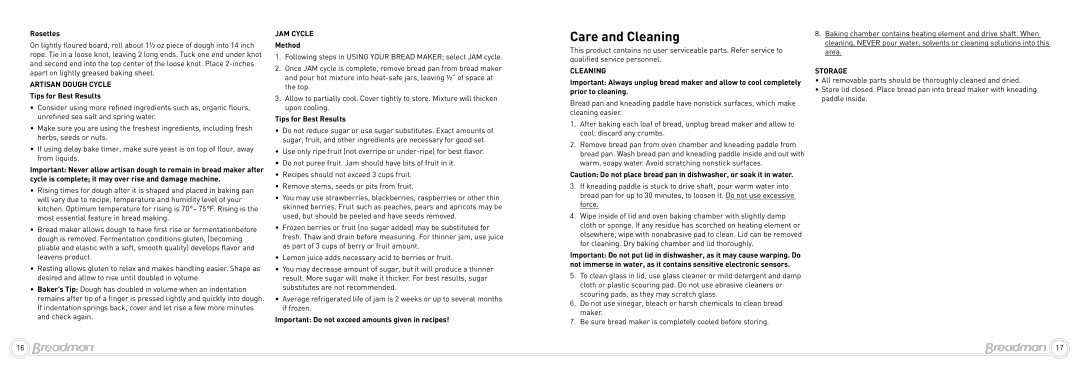BK1060S, Professional Bread Maker, BK1050S specifications
The Breadman BK1050S and BK1060S are two highly regarded professional bread makers that stand out in the crowded home bakery market. Designed with a blend of innovative technology and user-friendly features, these machines cater to both novice bakers and seasoned professionals, making them essential tools for whipping up delicious homemade bread.Starting with the Breadman BK1050S, this unit is crafted with a sleek design that seamlessly blends into any kitchen decor. It boasts a large LCD display, which enhances usability by providing clear instructions and time displays. With its unique 14 different baking functions, including gluten-free settings, users can experiment with various recipes to create anything from classic white bread to artisan-style loaves. The BK1050S also features a powerful kneading blade that thoroughly mixes ingredients, ensuring a perfect dough consistency.
One of the standout features of the BK1050S is its 2-pound baking capacity. This is ideal for larger families or those who love to entertain guests. The machine automatically adjusts baking time and temperature, ensuring consistent results every time. Moreover, its 15-hour delay timer allows users to prepare their ingredients in advance, so they can wake up to the smell of freshly baked bread, a feature that enhances convenience for busy lifestyles.
Transitioning to the Breadman BK1060S, it builds upon the successes of its predecessor with additional technological enhancements. The BK1060S incorporates a sleek stainless steel exterior, elevating its aesthetic appeal. This model offers an upgraded 25 baking functions, providing even more versatility for the adventurous baker. It also boasts a larger viewing window, allowing users to monitor the baking process without opening the lid, thus maintaining the internal temperature.
In terms of performance, the BK1060S features a dual kneading blade system, which not only ensures better dough mixing but also leads to a fluffier texture in the finished bread. The non-stick baking pan simplifies the cleaning process, making it an easy task to maintain this sophisticated kitchen appliance.
Both models prioritize safety with features like an automatic shut-off and a cool-touch housing to prevent burns. Their comprehensive user manuals provide guidance not only on operating the machines but also on recipe suggestions, making it easier for users to get started.
In conclusion, the Breadman BK1050S and BK1060S are exceptional bread makers that combine functionality, efficiency, and style. With their diverse baking functions and thoughtful design, they empower users to create bakery-quality bread in the comfort of their own homes. Whether you're a bread-making novice or an experienced baker, these machines offer countless possibilities for culinary creativity.
